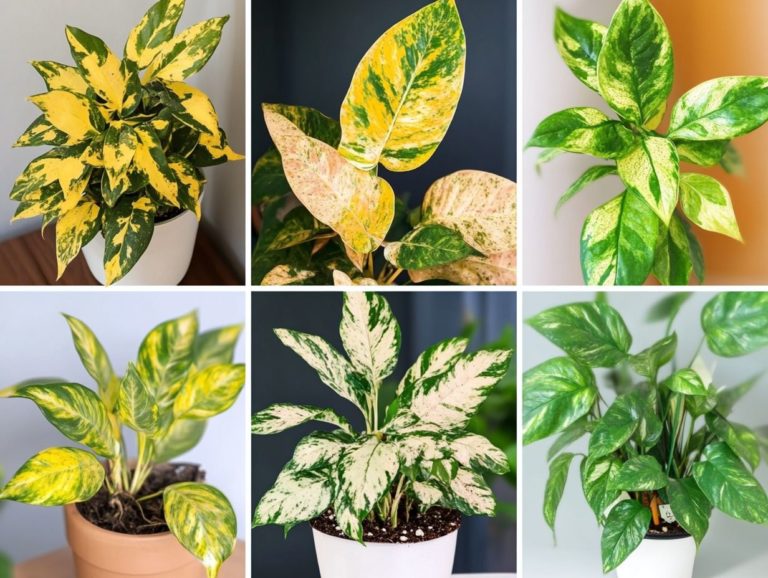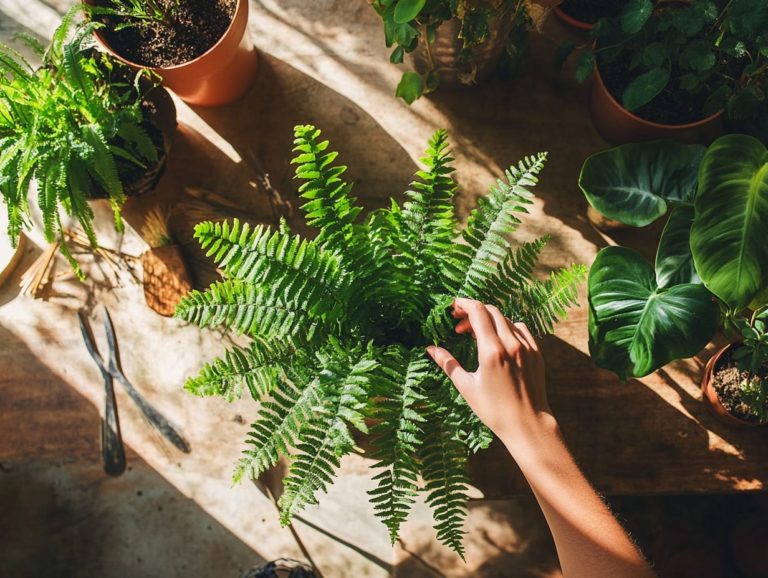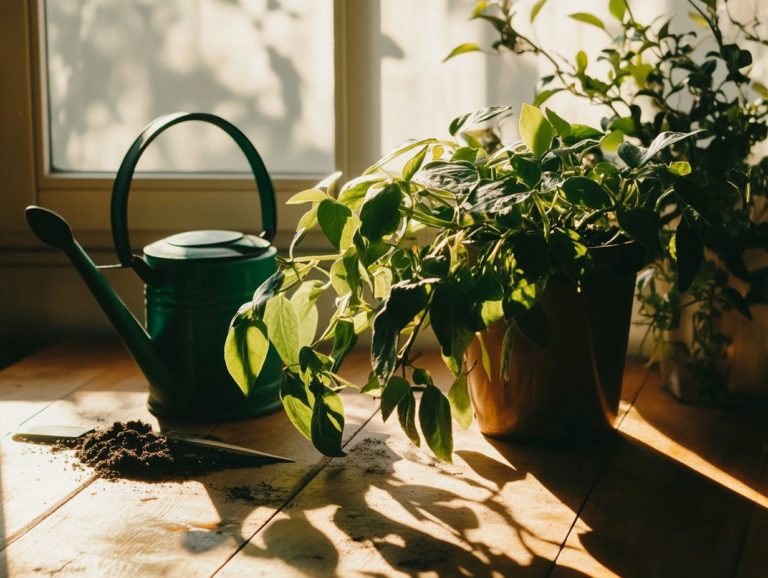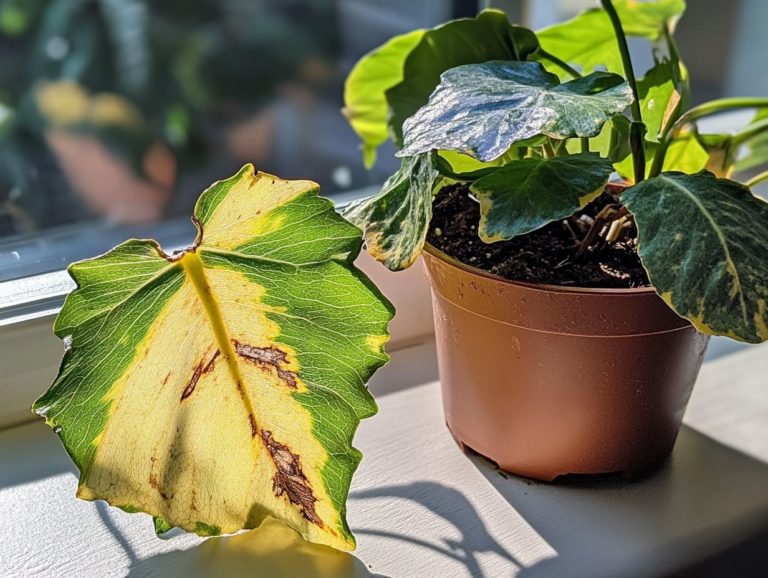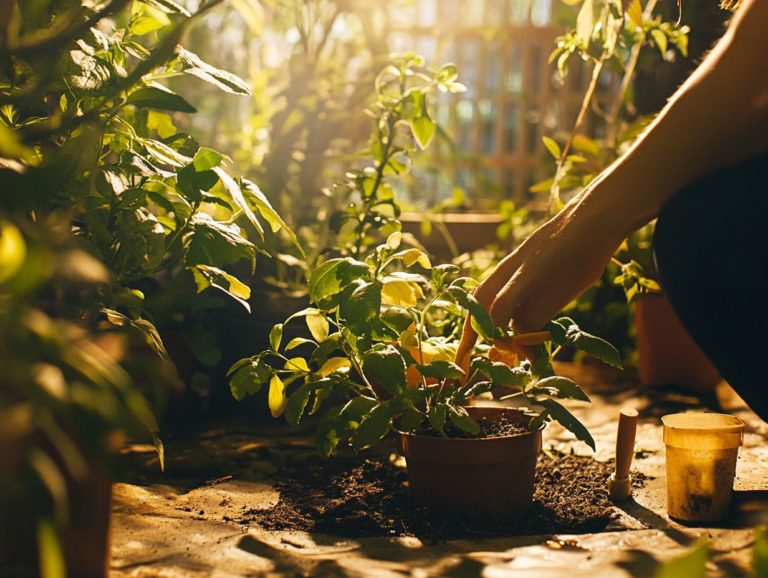Tips for Keeping Indoor Plants Thriving
Indoor plants offer more than just decoration. They can transform your environment and boost your well-being.
Adding greenery to your indoor space has many benefits, from purifying the air to lifting your mood. Choosing the right plants and helping them thrive takes some know-how.
This article covers key factors for plant selection, care tips, common problems, and creative display ideas. Discover how to make your indoor garden shine!
Contents
Key Takeaways:

- Indoor plants improve air quality and boost mood and productivity.
- When selecting plants, consider lighting, space, and maintenance needs.
- Proper care includes adequate lighting, watering, and fertilizer. Know common issues like pests and diseases.
Benefits of Indoor Plants
Indoor plants provide numerous benefits for your living and working spaces. They filter toxins and can uplift your mood.
Houseplants have gained popularity and scientific support. They help maintain healthy humidity levels and create a balanced atmosphere.
Understanding the many benefits of these green companions may inspire you to nurture a vibrant space. This fosters both plant vitality and personal growth.
Improved Air Quality and Mood
Indoor plants enhance air quality and uplift your mood. They create a tranquil environment at home or in the office.
These plants filter out pollutants like formaldehyde and carbon monoxide, leading to healthier spaces. Their natural processes increase humidity, which can ease respiratory issues.
Plants like ferns and ZZ plants also bring a sense of calm. Spending time with nature even indoors can reduce stress and boost your creativity. It s a great reason to add indoor plants to your daily routine!
Choosing the Right Plants for Your Space
Selecting the right indoor plants is essential for their health. Each type has specific needs for light, humidity, and care.
The natural light in your space, whether bright or low, determines which plants will thrive. Understanding what the ideal conditions for indoor plants are and how seasonal changes affect plant care is crucial for keeping your greenery healthy.
Factors to Consider
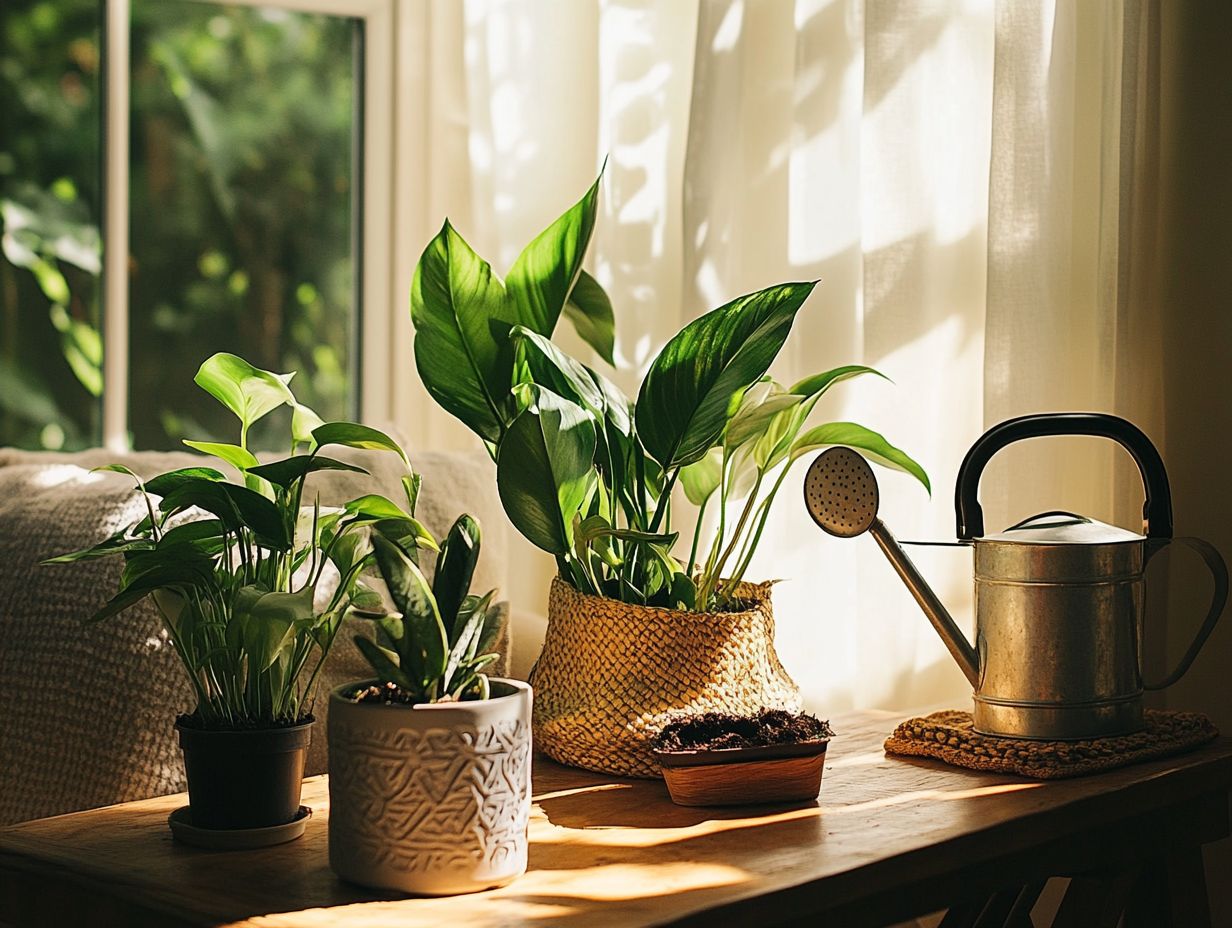
When you re choosing indoor plants, several key factors are essential to creating a thriving environment for their growth. You ll want to pay close attention to light, humidity, temperature, and soil conditions.
Understanding light exposure is crucial, as each plant has its own unique requirements. Direct light near south-facing windows is perfect for sun-loving varieties like succulents or cacti. This exposure promotes strong growth and vibrant colors.
Bright light slightly less intense works wonders for plants like ferns or pothos. These plants can flourish without the risk of scorching.
Even in low light conditions, found in shaded corners or rooms with minimal sunlight, you can nurture hardy species like snake plants, ZZ plants, or ferns. For effective care, consider following the most effective indoor plant care tips. Although their growth may be a bit slower, they can still thrive.
Humidity and temperature also play a crucial role. Tropical plants typically thrive in higher humidity levels and prefer temperatures around 65-75 F. Ensuring adequate soil moisture and shielding your plants from drafts will enhance your indoor gardening experience. For more insights, check out the best practices for indoor plant care.
Essential Care Tips for Indoor Plants
Caring for your indoor plants is an exciting journey that starts with a few essential practices to ensure their health and growth. This includes establishing a proper watering schedule and providing appropriate light exposure.
Each plant species has its own unique set of care requirements, so it’s crucial to pay attention to their specific needs for moisture, drainage, and nutrients. Whether you’re nurturing ferns, orchids, or succulents, understanding what to look for when buying indoor plants gives you the power to maintain vibrant, thriving houseplants.
Lighting, Watering, and Fertilizing
Understanding the delicate balance between lighting, watering, and fertilizing is essential for the thriving growth of your indoor plants. These elements directly affect their overall health, vitality, and longevity.
Proper lighting is a game-changer; natural light fuels photosynthesis, the process plants use to make food from sunlight, enabling them to flourish in their unique environments. Direct light can be a boon for sun-loving species, helping them reach their full potential.
Establishing a consistent watering schedule is equally important. This ensures each plant receives just the right amount of moisture, helping you avoid overwatering, drought stress, and root rot.
Choosing the right fertilizer is about knowing your plants. Some may thrive on high nitrogen formulas, while others need nutrient-specific blends tailored to their needs.
By mastering these crucial care aspects, you can cultivate a nurturing atmosphere that fosters vibrant growth and longevity in your indoor garden.
Common Issues and How to Solve Them
Indoor plants, though typically hardy, can face a range of common challenges that demand your immediate attention. Pests, diseases, and root rot are among the issues that, if not addressed promptly, can jeopardize their vitality.
Don t wait! Addressing pests and diseases promptly can save your plants from serious harm. Check your plants now and ensure they re thriving!
With the right care, your indoor garden can flourish beautifully!
Dealing with Pests and Diseases
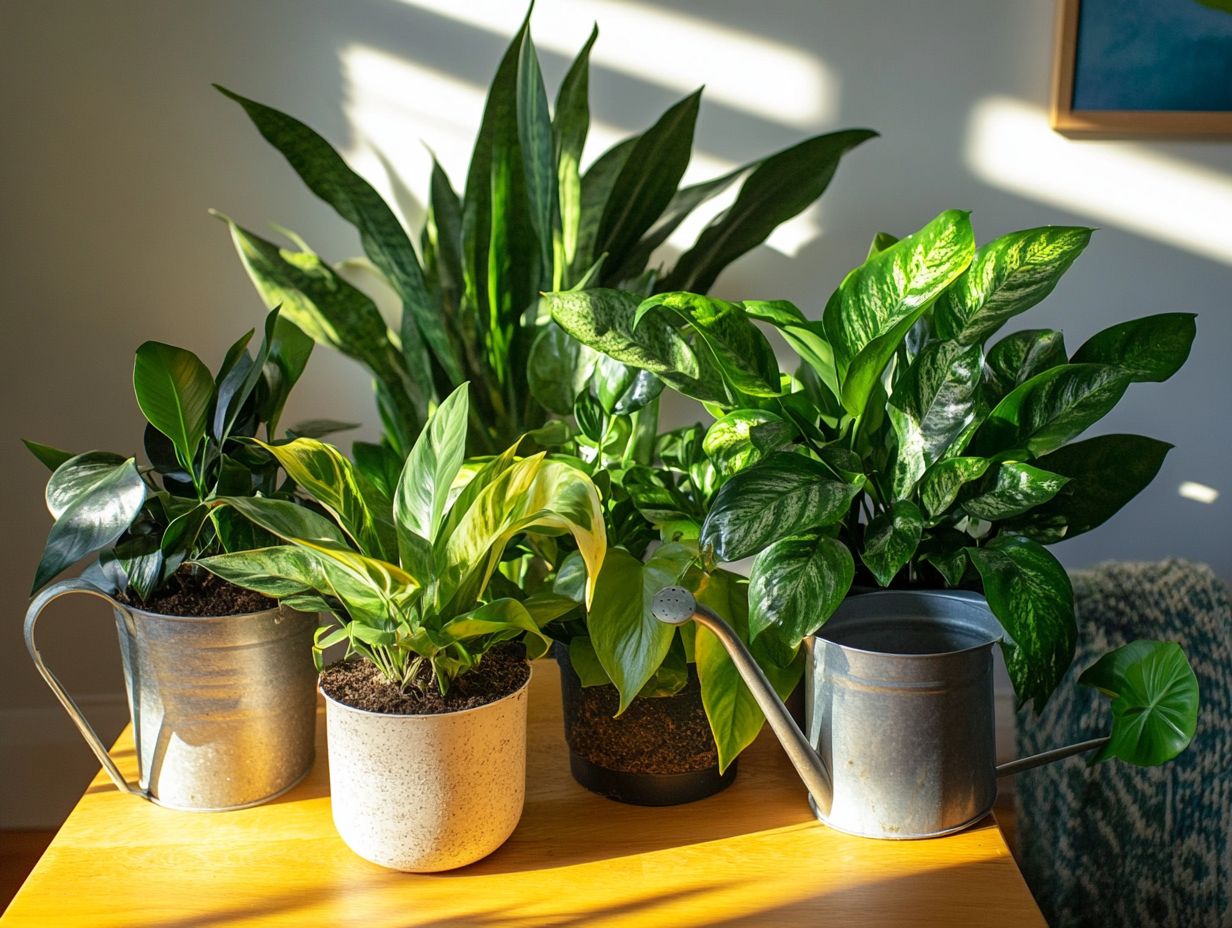
Addressing pests and diseases in your indoor plants is essential. Neglecting these issues can lead to a significant decline in their health and vitality.
Common causes include spider mites, aphids, and mealybugs. These pests can seriously damage your plants if left unchecked. Fungal issues, such as powdery mildew, thrive in overly humid conditions.
To combat these threats, regular inspections are key. Check the undersides of leaves and the soil to catch any issues early on. Using natural remedies like neem oil or insecticidal soap offers effective solutions.
Ensuring proper air circulation helps prevent many fungal diseases. By maintaining balanced watering habits and providing ample light, you can create a resilient environment for your indoor plants. If you’ve been away, check out these tips for reviving indoor plants after travel to create a resilient environment today!
Creative Ways to Display Indoor Plants
Creatively displaying indoor plants, including air plants and succulents, elevates your home decor and fosters a healthier environment. Showcase your houseplants in unique and visually captivating ways.
From crafting DIY planters to arranging them based on light and humidity conditions, the possibilities for integrating greenery into your living spaces are endless. Embrace innovative display techniques to cultivate a vibrant indoor garden.
DIY Planters and Decor Ideas
Creating DIY planters and decor ideas for your indoor plants adds a personal touch that enhances your home’s ambiance. Showcase your greenery with unique potting mixes.
These innovative projects ignite your creativity and transform your living space into a lush, green oasis. Repurpose everyday items like mason jars and tin cans. Craft intricate macram hangers to explore endless possibilities.
Dive into step-by-step guides that outline necessary materials, such as different soil types or potting mixes, along with specific planting techniques tailored for each unique container. Whether you choose a rustic wooden planter box or an elegant ceramic pot, these ideas invite vibrant greenery into your home.
They promote a serene atmosphere while refining your indoor gardening skills and ensuring proper plant care.
Frequently Asked Questions
Why are my indoor plants dying?

Indoor plants can die for various reasons, including lack of proper lighting, over or under watering, and pest infestations. Assess the specific needs of your plants and make adjustments accordingly to keep them thriving.
How often should I water my indoor plants and what type of light is best?
The watering frequency for indoor plants varies depending on the type of plant, the size of the pot, and the environment. Generally, most plants need to be watered once or twice a week. Check the soil moisture level before watering to avoid overwatering.
Most indoor plants thrive in bright, indirect light. Some require more or less light, so researching the specific needs of your plants is essential. If you encounter issues, consider checking out the top tips for indoor plant care troubleshooting. You may also need to supplement with artificial lighting if your home lacks natural light.
How can I prevent pests from infesting my indoor plants?
Pests can be a common problem for indoor plants, but there are steps you can take to prevent infestations. Regularly inspect your plants for pests. Avoid overwatering, as it can attract pests. Consider using natural pest control methods such as neem oil or insecticidal soap.
What should I do if my indoor plant’s leaves are turning yellow?
Yellow leaves can indicate over or under watering, lack of nutrients, or pests. Assess the specific needs of your plant and make any necessary adjustments. Trimming off the yellow leaves can also help promote new growth.
Are there any alternative methods for watering indoor plants?
Looking for new ways to keep your indoor plants happy? Try bottom watering! This method allows your plants to soak up water from the bottom, ensuring they stay hydrated.
Self-watering pots are another fantastic option. You can even make your own system with easy-to-use drip irrigation tools!

